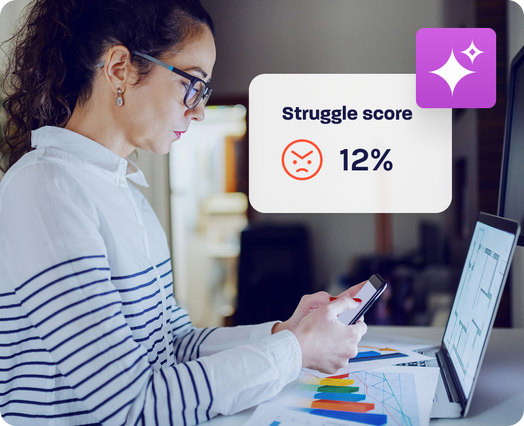
Page Experience & Core Web Vitals
Google has been focusing on user experience for some time as a response to changing web browsing behavior. Users are more likely to stay on websites that load quickly and offer frictionless journeys, and Google wants to offer the best experiences to their users through their search results. With the biggest change to the Google algorithm in years, page experience signals will become a much larger factor in Google Search ranking starting in May.
This change will have a huge impact on SEO. High-quality, relevant content is still hugely important, but Google will give top billing to search results that not only match the search query but also have better scores on page experience metrics.
Why page experience? Why now?
All the way back in 2010, Google announced that site speed would become a new ranking factor for its organic search-ranking algorithm. Indeed, the likes of SEO gurus Moz have been urging marketers to think of SEO as Search Experience Optimization for years.
Now, more than 10 years on, they’re kicking it up a notch by making page experience an even more integral factor in their rankings. Last year, Google introduced Web Vitals, a program to help website owners “quantify the experience of [their] site and identify opportunities to improve.” The new update will put even greater importance on page experience factors like loading time, interactivity and visual stability (on top of mobile-friendliness, security and content accessibility) through a set of metrics called Core Web Vitals.
Core Web Vitals includes the measurements Largest Contentful Paint (LCP), First Input Delay (FID) and Cumulative Layout Shift (CLS), which will play a much larger part in rankings, now starting in mid-June 2021. These metrics are essential aspects of user experience. I think we’d all agree that a website is far more enjoyable when the pages load quickly, when they can be interacted with instantly, and are stable as they render.
And it’s not just important for SEO. According to Google, users are 24% less likely to abandon page loads when Core Web Vitals pass. Companies who invest in page experience see a knock-on positive effect on customer experience, conversion and revenue.
Don’t forget mobile experience!
I would be remiss not to mention mobile experience in a blog about Google algorithm changes. According to Forrester, 69% of adults and 82% of youth in the US say that they expect companies to make their websites mobile-friendly. So it makes sense that Google has been focused on serving up sites to their users that provide better experience on mobile. Mobile-first indexing, in which the Google algorithm uses the mobile version of a website to index for search, has been the default for a while. But now mobile-first is mobile-only.
In March 2021, Google updated the algorithm to use only the mobile version of a website to evaluate its relevance to the search query. Essentially, Google now only looks at your website on mobile. So if you’ve got content that’s visible on desktop, but not on mobile, it is invisible to Google. It can’t be indexed, and thus won’t contribute to your ranking in search.
So, if you’re not designing your website journeys with a mobile-first approach, now’s the time to start.
What are the Core Web Vitals?
Each Core Web Vital has a score that will combine to form the final Page Experience score. Of course, Google’s not sharing the exact ratio of each factor, but if you’re not passing on all three metrics, you probably won’t rank well.
Largest Contentful Paint (LCP)
Google uses Largest Contentful Paint (LCP) to measure “perceived load speed.” LCP occurs when the page’s main content has loaded—usually the hero section at the top of the page. Google wants to see this happen in 2.5 seconds or less for a passing score. This is the hardest metric to pass.
First Input Delay (FID)
First Input Delay (FID) is how long it takes for the site to respond to your first input (a tap or click, for example, but not scrolls or zooms). According to Google, “it quantifies the experience users feel when trying to interact with unresponsive pages—a low FID helps ensure that the page is usable.” A passing score is 100 milliseconds or less.
Cumulative Layout Shift (CLS)
Cumulative Layout Shift (CLS) measures “visual stability because it helps quantify how often users experience unexpected layout shifts—a low CLS helps ensure that the page is delightful.”
This is referring to the webpage layout changing unexpectedly without you moving it or taking an action. We’ve all experienced a website that bounces around as the page renders (been to any recipe blogs lately?). This is often referred to as “jank,” and it has a negative impact on user experience.
The CLS score is determined by impact fraction and distance fraction. The impact fraction is determined by the area of the page within your view that’s impacted by the shift—essentially, the surface area of your screen where the layout is moving. The distance fraction refers to how far the layout shifts.
The calculation for CLS looks like this:
Impact fraction x distance fraction = CLS
Your score should be less than 10% or 0.1 to pass.
Clear as mud, right? Don’t worry. Google has made some tools to help you with your scores.
How can I figure out my scores?
Google has developed a few free tools to help you understand how your website scores. The Chrome User Experience Report collects real-user measurement (RUM) data for each of the three Core Web Vitals. This is anonymized data from real sessions on your website on a variety of devices and network conditions. This data is then fed into tools like PageSpeed Insights and Search Console’s Core Web Vitals report. Google also uses lab data which is based on a simulated load of a page within a fixed set of conditions (currently on a mid-tier device [Moto G4] on a mobile network). Lab data is good for debugging performance issues while real-user data can reveal true, real-world user experience.
PageSpeed Insights and Search Console show you the aggregate experience of sessions on a particular page over the previous 28-day collection period. You want your score to be at 75% or above for each metric—that is passing. That means that 75% (or more) of the visits to your page are within the targeted limit for that factor.

The PageSpeed Insights tool flags “opportunities” or areas of improvement. Google recommends that you try to reproduce the issues shown here with a session replay solution to understand what’s happening and develop a course of action.
Once you’ve completed work to improve your vitals, you can tell the Google Search Console tool that an issue is fixed by clicking the Validate Fix button. The 28-day clock starts over again, so you’ll be able to see at the end of that month if your fixes have worked.
Limitations of Google’s tools
Slows improvements
I know what you might be thinking—28 days is a really long time in the digital world. Waiting a full month to see the effect your work has had on real users isn’t ideal. Simulated lab data can be handy but it doesn’t show the real-world impact—which is what really counts when it comes to the success of your business.
You can’t afford to wait a month to see if your changes have improved your scores. A digital experience analytics tool can track these same Core Web Vitals in real time and over any time period)—with real user session data. Plus, you can integrate A/B tests to see which version of the page has the best scores so you can put changes in place faster.

Limited context
While the Search Console Insights tool does flag areas of improvement, it doesn’t tell you the extent of the issues across your site and only provides a very cursory level of insight. Supplementing with a digital experience analytics tool with built-in artificial intelligence (AI) helps you iterate at speed by highlighting anomalies and where users are struggling on each page. Modern tools let you see pages as part of a larger journey and show how a slow or “janky” experience on one page can impact abandonment on another.
Plus, it helps you measure the Core Web Vitals on pages that Google can’t crawl, so your customers can continue to enjoy a smooth, speedy experience even after they log in.
No business impact measurements
While it may seem obvious that better scores on Core Web Vitals will translate to higher revenues from your site, Google’s tools don’t help you measure the impact on your bottom line. Advanced digital experience analytics tools can calculate the impact of page experience issues on revenue, taking into account the customer journey, referral source and event customer segments. This helps you create buy-in internally and prioritize resources.
The SEO basics like keywords, meta descriptions and internal links, are all still important. But come June, SEO becomes a whole new ball game as user experience takes on higher importance. Rather than optimizing your site for bots, focus on your users the way they’re using your site. It’s time to get a digital experience analytics platform in place to supplement Google’s tools so you can improve your page experience faster, track user experience across your entire site and measure the revenue impact of your optimization efforts.








